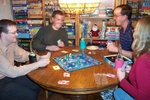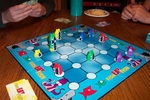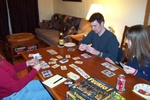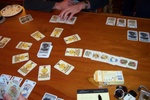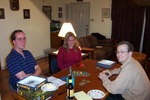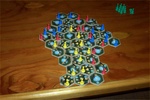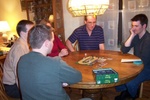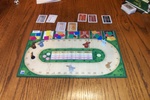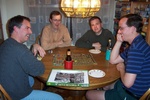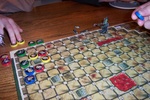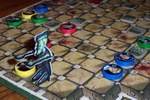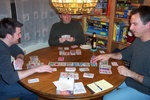
Games: Fish Eat Fish, Die Fugger, Feurio!, Royal Turf
Attendees: Doug, Ed, Jon, Mark, Mike, Roxana, Susan
Reporter: Susan Rozmiarek
We have really enjoyed meeting in person and playing host to several online friends this year and tonight we welcomed Mike Chapel. The bonus with Mike is that he lives close by so we might be able to coax him into returning on a regular basis. And he made points with me right off the bat for being on time, giving us enough players to start a game immediately.
While we were a little short on players tonight we were definitely not short on games. Mark arrived bearing a nice pile of new Essen releases and we also had a several of our own to take for a spin.
First up, while waiting for everyone else to arrive, was the new-ish Knizia game from Out of the Box:
Fish Eat Fish: Ed, Mark, Mike, Susan
My parakeet alarm starting tweeting loudly as soon as the box was opened. The art was plain but very cute. The brightly colored, stacking piranha-type fish were fabulous and the detailed starfish was nice overkill. The rules were simple and we started chomping on each other in no time.
As Sarah S. indicated on Spielfrieks, this game is simply brutal. It's easy to be deceived by its cute, childish look. On every turn, you are required to attack other fish or set yourself up for attack. The feeding frenzy starts immediately. Everybody has the same set of cards with a numeric value on each along with a few special cards. Both players involved in an attack secretly choose a card and they are simultaneously revealed. The number on the card added to the number of fish in the stack determines the winner. An octopus card nullifies the attack and a shark card always wins. A nasty part of this involves ties. If the players tie (except with octopi), all fish from both stacks are removed and out of the game. The winner places his stack atop the loser's, with fish in excess of five removed and becoming part of the winner's catch. The player with the last remaining stack(s) gets to add all of the fish in those stacks to his catch. Whoever has caught and devoured the most fish wins.
Mike jumped out to an aggressive start and was looking like a real threat early-on. Unfortunately for him, he burned his best cards early and ended up being eliminated first. Next out was Doug and then Mark. Finally, Ed gobbled up my last stack and added all the fish in my stack plus his to his catch for a landslide win.
Results: We forgot to write down the scores but they were something like this:
Ed 12, Susan 4, Mark 3, Doug 0, Mike 0
I liked the game just fine, but it was just another bluffing game with mechanisms that felt very familiar. I think the bits were superb though, and Out of the Box is really starting to impress me as a company that puts out solid little games for a great price for what you get.
With the arrival of Jon and Roxana, we decided to split into two groups. Mark, Ed, Doug and Mike went off to flee the monster in Finstere Flure, while Jon, Roxana and I tried out a new Adlung card game.
Die Fugger: Jon, Roxana, Susan
This Essen release caught my eye due to some positive buzz and the fact that it was by Klaus-Jürgen Wrede, the designer of Carcassonne. For a pleasant change, the rules that came with the game were fairly clear, with no English translation of the English rules needed like many Adlung games. This is a simple economics game set in Medieval times. There are already some good descriptions of the game elsewhere (see the recent Westbank Gamers session report) so I'll just give a very brief summary of the gameplay.
Players take turns placing a card on the table in front them that depicts a particular good. Once five cards of a single good have been played, the round ends and the prices (in florins) are adjusted based on the number of each good played that round, with the top three going up an amount equal to the number of cards of that good played and the others going down by one. The price chart is circular, going from one to nine, so when a good rises past nine, it in fact falls to one. After adjusting the prices, players sell their played goods for the current value and discard them. Then they get two new cards and a new round begins. There are also merchant cards that allow you to draw additional cards and good cards with a "royal seal" that are twice as valuable if three or fewer of that good are played. The game ends when a player reaches a 100 florins. There are a few other things in the game, but this is the general gist of it.
It took a few rounds to get the flow of things, but the game is rather simple. It is chaotic, but I felt like I had a little bit of control. I have a hunch there will be even less control with more players, given that the round ending condition of five cards of a single good played remains the same. Still, it is a pleasant filler. I did find it tedious to look around the table all the time and at the end of a round to determine how many of each good were in play. Also, scores have to be kept track of on paper. However, for a game that costs me about 5 Euros, I really can't complain.
Feurio!: Doug, Mark, Susan
This game is one of Mark's new acquisitions and it ended up being the hit of the evening with me. From the description, the game didn't impress me all that much. Draw and place a tile, then place a pawn-guy. Gee, does this sound all too familiar, or what? I didn't dismiss it though, as I love tile-drawing games. It's just so hard to find one with fresh mechanisms. Happily, Feurio seems to be just that, at least from my initial playing.
In Feurio, you are firefighters trying to put out a raging forest fire. To do this you are trying to form a chain of your firefighters from a water source on the outskirts of the forest to the hottest spots on the inside. Each tile has a number on it that indicates how hot it is. Tiles drawn must be placed on the "hottest" spot on the board which is determined by adding up the numbers on the surrounding tiles. Only if there is a tie between more than one spot do you get a choice of where to place the tile. After placing a tile you place up to three of your firefighters on any available tile. The maximum number allowed on a tile varies depending on its value and it decreases as the tile gets surrounded. You can also place a flipped tile to create firebreaks but it didn't happen much in our game. It is a very expensive option that nobody seemed eager to use. At the end of the game you score your chains of firefighters, adding up the numbers on the tiles on which they are located and dividing by the lowest number on an edge tile that they occupy.
Doug had a pretty big chain going but Mark and I were able to prevent him from getting to a "1" tile and his points were cut in half at the end by a "2" tile being his lowest edge tile. I had a decent chain but Mark had a couple that ended up totaling more than mine for the win.
Results: Mark 40, Susan 37, Doug 29
There is a little more than meets the eye at first blush with this game. We found ourselves driving the fire where we wanted it to go when given the choice, cutting each other off by filling up a key tile, and having to decide whether to go ahead and put a firefighter on a "1" tile early rather than securing a spot on a more valuable tile. I also think we were missing the advantages to placing a firebreak. I came away from the game starting to get a handle on some of the strategies and am eager to play it again. The theme of creating a chain of firefighters really worked for me, also. All in all a fun game that might get repetitious after repeated plays but will provide many enjoyable games before getting to that point, if it even does.
As a closer we were looking for a game that could include everyone remaining. Although our group had burnt out on Royal Turf awhile back, nobody objected when Mike suggested it, so we were off to the races.
Royal Turf: Doug, Mark, Susan
As I listened to Ed give a rules refresher, I tried to argue over at least three rules that I was either not remembering or had played incorrectly in the past. I thought that you could place multiple bets on a single horse, that the number of chits rather than the total bets is used in determining which column of the payout chart to use, and that info cards for each horse are discarded at the end of a round, not shuffled back in. I was gleefully shot down on each of these and proved wrong. Oh, well. I was taught the game and have never actually read the rules so I'm pleading innocent. Actually, I kind of like my variants. What does that Knizia guy know, anyway?!? (Editor's note: We have since learned that we had an old version of the rules which incorrectly states that the horse cards were shuffled in after each race. Apparently the correct way is to discard the horse cards after each race therefore using each card once.)
This particular game was a lot of fun, with plenty of whining, bluffing, and smack-talk. I guess it's still worth pulling out occasionally, especially if you have the awkward number of six players.
Results: Jon 2300, Ed 1850, Mark 1750, Susan 1400, Mike 950, Doug -100 (ouch!)
Obviously, Doug should stay away from the track if he wants to keep his shirt.
Other games played: Scream Machine, Finstere Flure
The initial reaction to Finstere Flure was very positive and Scream Machine is rapidly becoming one of our favorites.
For more pictures from this gaming sessions and others, see our Gaming Picture Gallery.
This page viewed
E-mail Ed Rozmiarek with questions or problems concerning this page.
Copyright © 2003, Ed Rozmiarek
